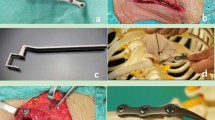Abstract
Introduction
Sternal fractures are rare with 3–8 % out of the total number of trauma cases mostly caused by direct impact to the anterior chest wall. Most cases described are due to motor vehicle crash either caused by direct impact to the steering wheel or by the seat belt. Fractures mainly occur to the sternal body. Only rarely are cases of manubrium fractures described in literature, for example, in relationship with a direct impact to the shoulder which caused an oblique fracture near to the sternoclavicular joint. Three patients with profoundly dislocated oblique manubrium fracture were admitted to our Level I Trauma Center in 2012 and 2013. Those patients suffered from instability of the upper sternum and the shoulder girdle.
Material and methods
Between January 2012 and October 2013, a total of 538 trauma patients were admitted to the emergency room and received whole body CT-scan. They were analysed retrospectively for sternal fractures. In cases of instability and dislocation, fracture stabilisation was performed by anterior plating through a medial approach using low profile titanium plates (MatrixRib®).
Results
Seventy-nine (14.7 %) patients showed sternal fracture, out of which 13 (2.4 %) patients showed a fracture of manubrium, ten caused by seatbelt. In three cases stabilization was performed. Follow up showed sufficient consolidation without complications.
Discussion
A total of 16.5 % of sternal fractures were localized at the manubrium, mostly caused by seat belt. Fractures without significant dislocation seemed to be stable and healed well under conservative treatment. Dislocation in this region leads to unstable shoulder girdle. Anterior plating provides sufficient stabilisation and allowed consolidation.




Similar content being viewed by others
References
Athanassiadi K, Gerazounis M, Moustardas M, Metaxas E (2002) Sternal fractures: retrospective analysis of 100 cases. World J Surg 26(10):1243–1246
Yeh DD, Hwabejire JO, DeMoya MA, Alam HB, King DR, Velmahos GC (2014) Sternal fracture–an analysis of the National Trauma Data Bank. J Surg Res 186(1):39–43
Helal B (1964) Fracture of the manubrium sterni. J Bone Joint Surg (Br) 46:602–607
Gurlt E (1864) Handbuch der Lehre von den Knochenbrüchen, Band II, Kap. III. Grot‘sche Buchhandlung, C. Müller, pp 264–315
Fowler AW (1957) Flexion-compression injury of the sternum. J Bone Joint Surg (Br) 39-B(3):487–497
Knobloch K, Wagner S, Haasper C, Probst C, Krettek C, Otte D, Richter M (2006) Sternal fractures occur most often in old cars to seat-belted drivers without any airbag often with concomitant spinal injuries: clinical findings and technical collision variables among 42,055 crash victims. Ann Thorac Surg 82(2):444–450
Velutini JA, Tarazona PF (1998) Fracture of the manubrium with posterior displacement of the clavicle and first rib. A case report. Int Orthop 22(4):269–271
Lane WA (1884) One mode of fracture of the sternum. Trans Pathol Soc London 35:253
Kehdy F, Richardson JD (2006) The utility of 3-D CT scan in the diagnosis and evaluation of sternal fractures. J Trauma 60(3):635–636
Nakae H, Tajimi K, Kodama H (2003) Diagnosis of a fractured manubrium aided by three-dimensional computed tomographic scanning. J Trauma 55(1):139–140
Scheyerer MJ, Zimmermann SM, Bouaicha S, Simmen HP, Wanner GA, Werner CM (2013) Location of sternal fractures as a possible marker for associated injuries. Emerg Med Int 2013:407589
Gibson LD, Carter R, Hinshaw DB (1962) Surgical significance of sternal fracture. Surg Gynecol Obstet 114:443–448
Rambaud G, Desachy A, François B, Allot V, Cornu E, Vignon P (2001) Extrapericardial cardiac tamponade caused by traumatic retrosternal hematoma. J Cardiovasc Surg (Torino) 42(5):621–624
Deutsche Gesellschaft für Unfallchirurgie (federführend) (2012) S3 – Leitlinie Polytrauma/Schwerverletzten-Behandlung; AWMF Register-Nr. 012/019; S71. http://www.awmf.org . Accessed 25 Nov 2014
Harston A, Roberts C (2011) Fixation of sternal fractures: a systematic review. J Trauma 71(6):1875–1879
Fawzy H, Alhodaib N, Mazer CD, Harrington A, Latter D, Bonneau D, Errett L, Mahoney J (2009) Sternal plating for primary and secondary sternal closure; can it improve sternal stability? J Cardiothorac Surg 4:19
Schulz-Drost S, Syed J, Besendoerfer M, Carbon RT (2014) Sternocostal dislocation following open correction of pectus excavatum-“stairway phenomenon”: complication management by means of sternocostal locking titanium plate osteosynthesis. Thorac Cardiovasc Surg 62(3):245–252
Bottlang M, Long WB, Phelan D, Fielder D, Madey SM (2013) Surgical stabilization of flail chest injuries with MatrixRIB implants: a prospective observational study. Injury 44(2):232–238
Schulz-Drost S, Mauerer A, Grupp S, Hennig FF, Blanke M (2014) Surgical fixation of sternal fractures: locked plate fixation by low-profile titanium plates–surgical safety through depth limited drilling. Int Orthop 38(1):133–139
Alkadhi H, Wildermuth S, Marincek B, Boehm TJ (2004) Accuracy and time efficiency for the detection of thoracic cage fractures: volume rendering compared with transverse computed tomography images. Comput Assist Tomogr 28(3):378–385
Byard RW (2002) Shoulder-lap seat belts and thoracic transection. J Clin Forensic Med 9(2):92–95
Schulz-Drost S, Oppel P, Grupp S, Schmitt S, Carbon RT, Mauerer A, Hennig FF, Buder T (2015) Surgical fixation of sternal fractures: preoperative planning and a safe surgical technique using locked titanium plates and depth limited drilling. J Vis Exp 95:e52124. doi:10.3791/52124
Conflict of interest
The first author has a consultant agreement with SynthesCMF. No funds were received in connection to the presented study. The coauthors declare that they have no competing interests.
Author information
Authors and Affiliations
Corresponding author
Rights and permissions
About this article
Cite this article
Schulz-Drost, S., Oppel, P., Grupp, S. et al. The oblique fracture of the manubrium sterni caused by a seatbelt—a rare injury? Treatment options based on the experiences gained in a level I trauma centre. International Orthopaedics (SICOT) 40, 791–798 (2016). https://doi.org/10.1007/s00264-015-2801-z
Received:
Accepted:
Published:
Issue Date:
DOI: https://doi.org/10.1007/s00264-015-2801-z




